Solar eclipse of May 10, 1994
| Solar eclipse of May 10, 1994 | |
|---|---|
 Map | |
| Type of eclipse | |
| Nature | Annular |
| Gamma | 0.4077 |
| Magnitude | 0.9431 |
| Maximum eclipse | |
| Duration | 373 sec (6 m 13 s) |
| Coordinates | 41°30′N 84°06′W / 41.5°N 84.1°W |
| Max. width of band | 230 km (140 mi) |
| Times (UTC) | |
| Greatest eclipse | 17:12:27 |
| References | |
| Saros | 128 (57 of 73) |
| Catalog # (SE5000) | 9495 |
An annular solar eclipse occurred on May 10, 1994. A solar eclipse occurs when the Moon passes between Earth and the Sun, thereby totally or partly obscuring the image of the Sun for a viewer on Earth. An annular solar eclipse occurs when the Moon's apparent diameter is smaller than the Sun's, blocking most of the Sun's light and causing the Sun to look like an annulus (ring). An annular eclipse appears as a partial eclipse over a region of the Earth thousands of kilometres wide. The path of annularity crossed Baja California, Mexico, the United States and the Canadian provinces of Ontario and Nova Scotia.
Images

Related eclipses
Solar eclipses 1993-1996
Each member in a semester series of solar eclipses repeats approximately every 177 days and 4 hours (a semester) at alternating nodes of the Moon's orbit.
| Descending node | Ascending node | |||
|---|---|---|---|---|
| Saros | Map | Saros | Map | |
| 118 | May 21, 1993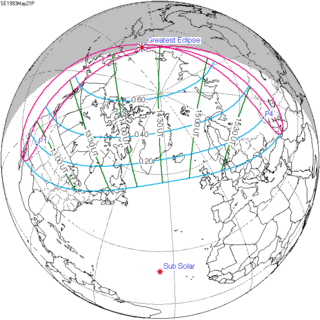 Partial |
123 | November 13, 1993 Partial | |
| 128 | May 10, 1994 Annular |
133 | November 3, 1994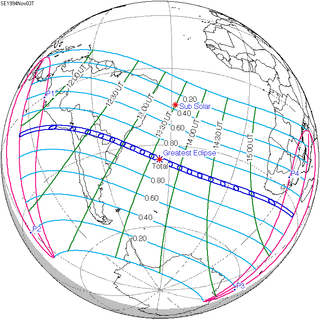 Total | |
| 138 | April 29, 1995 Annular |
143 Totality at Dundlod, India | October 24, 1995 Total | |
| 148 | April 17, 1996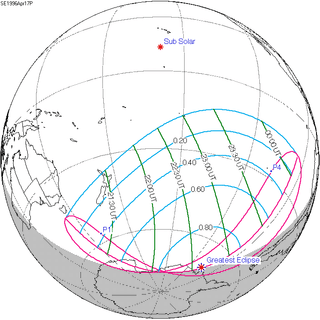 Partial |
153 | October 12, 1996 Partial | |
Saros 128
It is a part of Saros cycle 128, repeating every 18 years, 11 days, containing 73 events. The series started with partial solar eclipse on August 29, 984 AD. It contains total eclipses from May 16, 1417 through June 18, 1471 and hybrid eclipses from June 28, 1489 through July 31, 1543. Then it progresses into annular eclipses from August 11, 1561 through July 25, 2120. The series ends at member 73 as a partial eclipse on November 1, 2282. The longest duration of totality was 1 minutes, 45 seconds on June 7, 1453.[1]
| Series members 52–62 occur between 1901 and 2100 | ||
|---|---|---|
| 52 | 53 | 54 |
 March 17, 1904 |
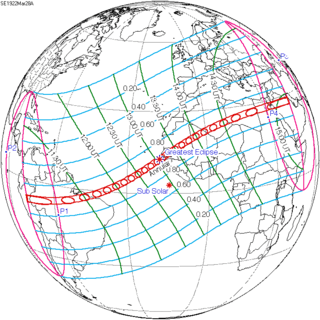 March 28, 1922 |
 April 7, 1940 |
| 55 | 56 | 57 |
 April 19, 1958 |
 April 29, 1976 |
 May 10, 1994 |
| 58 | 59 | 60 |
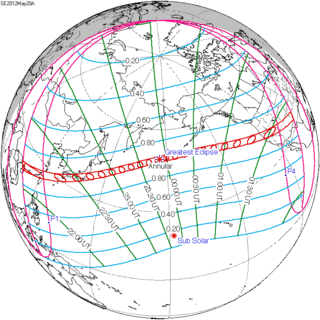 May 20, 2012 |
 June 1, 2030 |
 June 11, 2048 |
| 61 | 62 | |
 June 22, 2066 |
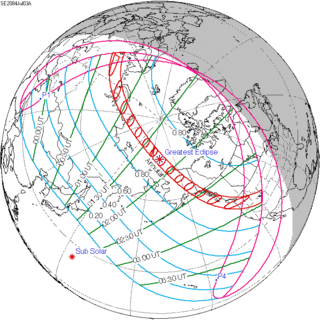 July 3, 2084 | |
Metonic cycle
The metonic series repeats eclipses every 19 years (6939.69 days), lasting about 5 cycles. Eclipses occur in nearly the same calendar date. In addition the octon subseries repeats 1/5 of that or every 3.8 years (1387.94 days).
| 21 events between July 22, 1971 and July 22, 2047 | ||||
|---|---|---|---|---|
| July 21-22 | May 9-11 | February 26-27 | December 14-15 | October 2-3 |
| 116 | 118 | 120 | 122 | 124 |
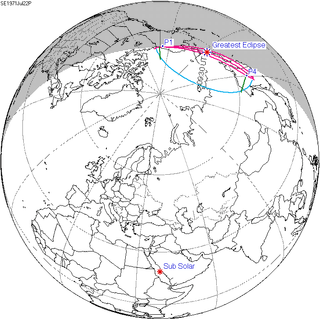 July 22, 1971 |
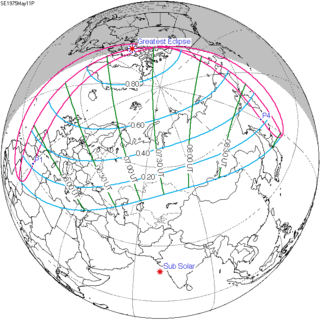 May 11, 1975 |
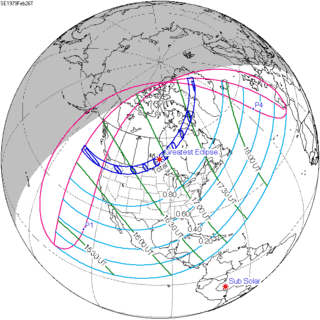 February 26, 1979 |
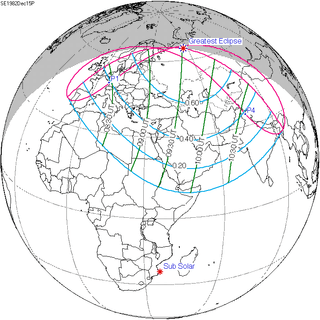 December 15, 1982 |
 October 3, 1986 |
| 126 | 128 | 130 | 132 | 134 |
 July 22, 1990 |
 May 10, 1994 |
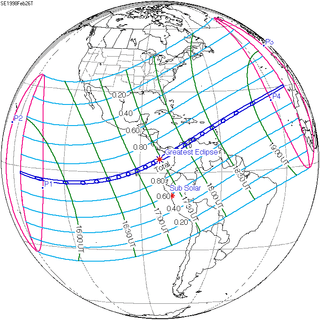 February 26, 1998 |
 December 14, 2001 |
 October 3, 2005 |
| 136 | 138 | 140 | 142 | 144 |
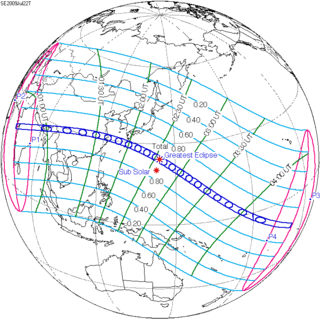 July 22, 2009 |
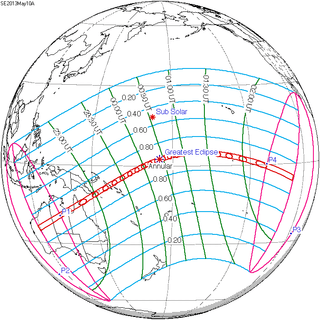 May 10, 2013 |
 February 26, 2017 |
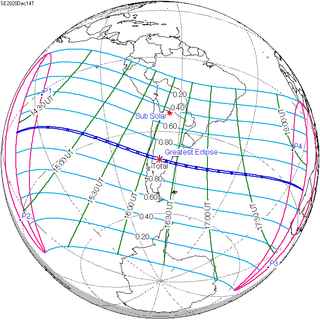 December 14, 2020 |
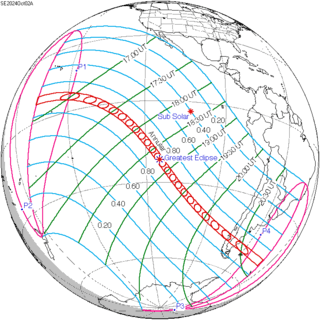 October 2, 2024 |
| 146 | 148 | 150 | 152 | 154 |
 July 22, 2028 |
 May 9, 2032 |
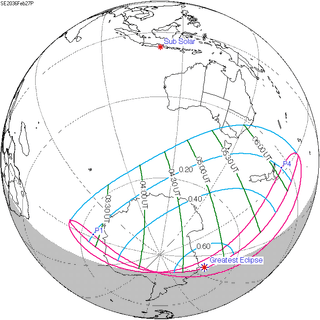 February 27, 2036 |
 December 15, 2039 |
 October 3, 2043 |
| 156 | ||||
 July 22, 2047 | ||||
References
External links
- Earth visibility chart and eclipse statistics Eclipse Predictions by Fred Espenak, NASA/GSFC
Photos:
- Solstice And Season's Eclipse APOD 21 December 2000, partial annular eclipse
| Wikimedia Commons has media related to Solar eclipse of 1994 May 10. |
